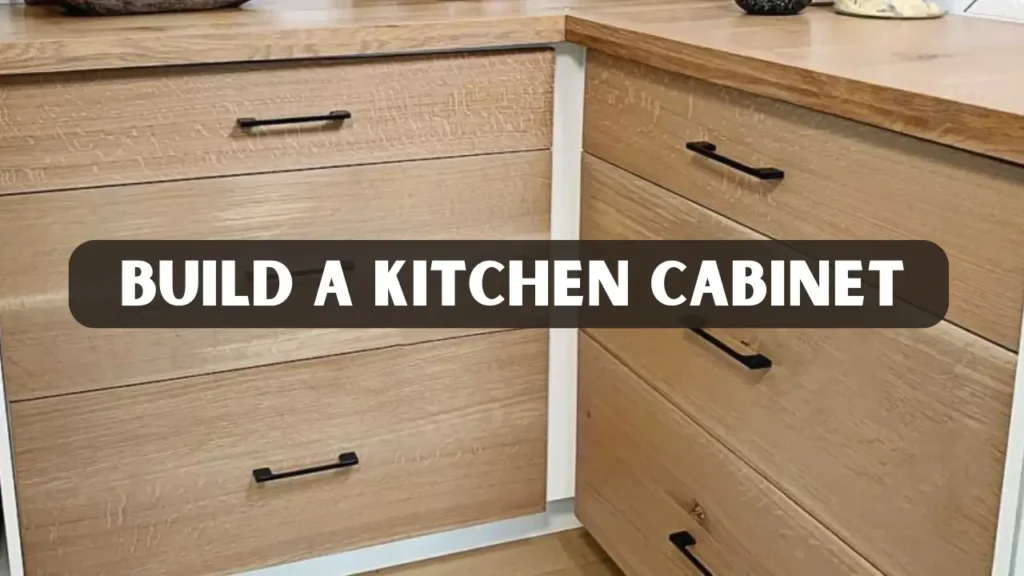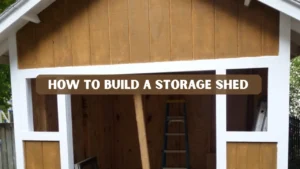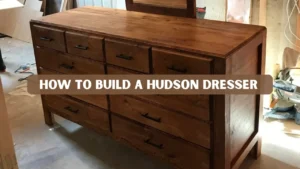Key Takeaways
- Building your own kitchen cabinet saves money and allows full customization.
- Proper planning, accurate measurements, and quality materials are essential for a successful project.
- Following step by step guides makes it easy for DIYers to successfully build a kitchen cabinet with professional results.
- Finishing techniques enhance durability and give a polished, professional appearance.
- Real-world examples show that building a kitchen cabinet is achievable and highly rewarding.
Why You Should Build a Kitchen Cabinet
Building a kitchen cabinet is a satisfying DIY woodworking project that combines creativity with functionality while saving money. By making your own cabinets, you control the design, materials, dimensions, and finishing touches. This project works for both small and large kitchens, allowing you to create custom storage solutions. In this guide, you will learn how to build a kitchen cabinet from planning and materials to assembly and finishing.
Building your own cabinets not only enhances your kitchen aesthetically but also provides a deep sense of accomplishment. Homeowners who take on such projects often find that it sparks more interest in woodworking and home improvement, leading to additional creative DIY endeavors.
Tools and Materials
Before beginning any project, preparation is critical. Gathering all necessary tools and materials ensures a smoother, safer, and more efficient building process.
Essential Tools:
- Circular saw or table saw for accurate cutting
- Power drill with a set of drill bits for assembly
- Clamps and measuring tape for stability and precision
- Screwdriver set for hinges and hardware
- Sandpaper or electric sander for smooth finishes
Materials:
- Plywood or solid wood panels for structural strength
- Wood glue for secure joints
- Screws and nails for assembly
- Cabinet hinges, handles, and drawer slides
- Paint, stain, or varnish for finishing
Tip: Using high-quality materials ensures your cabinet will be durable, functional, and visually appealing for years to come.
Planning Your Kitchen Cabinet Project
Careful planning is one of the most critical steps in successfully building a kitchen cabinet. Without accurate measurements and a clear design, even experienced DIYers can encounter issues.
Steps for Planning:
- Measure your space carefully to determine the height, width, and depth of the cabinet for a perfect fit.
- Choose a cabinet style that complements your kitchen design, such as modern, shaker, or traditional, to match your overall décor.
- Sketch your layout to plan the placement of shelves, drawers, and doors, ensuring functionality and efficient use of space.
- Select materials and finishes that align with your kitchen décor while providing the desired durability and long-lasting performance.
Additionally, planning the type of joinery and assembly method will save time during construction. Deciding whether shelves will be adjustable or fixed, and selecting hardware in advance, ensures a smoother workflow.
Step by Step Guide
Step 1: Cutting the Panels
Accurate cutting is essential, so measure twice and cut once using a circular or table saw for straight, clean edges. Label each panel clearly and consider cutting slightly larger panels to allow for sanding and trimming.
Step 2: Assembling the Cabinet Frame
Begin assembling the frame by joining panels with wood glue and screws, ensuring it is square using a carpenter’s square. Enhance durability with pocket holes or dovetail joints and double-check measurements to prevent gaps or misalignment.
Step 3: Installing Shelves and Dividers
Decide if your shelves will be fixed or adjustable, securing fixed shelves with wood glue and screws. For adjustable shelves, use pins or brackets, and add dividers to improve organization and functionality.
Step 4: Attaching Cabinet Doors
Attach cabinet doors using hinges with a template to ensure precise alignment and smooth operation. Consider soft-close hinges for a professional finish and test each door for level before final tightening.
Step 5: Sanding, Staining, and Finishing
Sand all surfaces thoroughly to remove rough edges and splinters, ensuring a smooth base. Apply primer, stain, or varnish according to your desired finish, using multiple coats and allowing each to dry completely for protection and durability.
Installing Your Kitchen Cabinet
Install the completed cabinet by securing it firmly to wall studs to ensure stability. Using a level, check that the cabinet is perfectly aligned before tightening all screws. Make sure each door and drawer operates smoothly without sticking or gaps. Proper installation ensures that the cabinet will function efficiently and last for years.
Adding a back panel can prevent warping and strengthen the overall structure. This small addition improves durability and maintains the cabinet’s shape. Careful installation provides both safety and long-term reliability.
Case Studies: Real-World DIY Success Stories
- Emily, a DIY enthusiast, decided to build a kitchen cabinet for her small urban kitchen, completing the project in a weekend with precise measurements and quality plywood, resulting in sleek, space-saving cabinets.
- Similarly, the Smith family renovated their outdated kitchen by building durable wooden cabinets with soft-close drawers over two weekends, saving thousands compared to buying custom cabinets and achieving a professional, functional finish.
Common Mistakes to Avoid
- Miscalculating measurements can lead to misfit cabinets that do not align properly. Always double-check dimensions before cutting or assembling.
- Skipping sanding or finishing results in rough or uneven surfaces. Proper sanding and finishing improve both appearance and durability.
- Using low-quality panels or hardware can compromise the cabinet’s strength and longevity. Choose durable materials to ensure lasting results.
- Failing to check level and alignment during assembly may cause doors and drawers to function poorly. Use a level frequently to maintain precision.
- Ignoring safety precautions when using power tools can lead to accidents or injuries. Always wear protective gear and follow tool instructions carefully.
By being aware of these common mistakes, you can avoid delays and ensure a professional-quality result.
Optional Upgrades for Your Cabinet
- Soft-close hinges and drawer slides provide smooth operation, preventing doors and drawers from slamming. They add a professional touch and enhance the cabinet’s durability.
- Pull-out shelves and organizers help maximize storage space efficiently, making it easier to access items and keep the kitchen organized.
- Decorative molding or trim enhances the cabinet’s overall appearance, giving it a polished and customized look that complements your kitchen style.
- Glass or frosted doors add a modern design element to your cabinets, creating an elegant visual appeal while allowing partial visibility of the contents.
Upgrades can increase both the functionality and aesthetic appeal of your cabinets, making them a worthwhile investment in the project.
Conclusion
Building a kitchen cabinet is a rewarding DIY project that combines craftsmanship with creativity. Careful planning, selecting quality materials, and paying attention to detail ensure that your build a kitchen cabinet looks professional and functions efficiently. Whether your kitchen is small or large, this project allows you to customize storage solutions to fit your needs. With the right approach, your cabinets can last for many years while enhancing your kitchen’s appearance.
Even beginners can successfully complete this project by following step by step instructions. Experienced DIYers can add personal touches or upgrades to make the cabinets unique. Creating your own cabinets provides a sense of accomplishment and pride in your work. Start today and enjoy the satisfaction of building something both functional and beautiful with your own hands.
FAQs
How long does it take to build a kitchen cabinet?
Most DIY builders complete a standard cabinet in 1–3 weekends, depending on skill level and complexity.
What is the best wood for kitchen cabinets?
Plywood, maple, oak, and birch are durable and provide excellent results for cabinetry.
Can beginners build their own kitchen cabinets?
Yes. With step-by-step instructions, proper planning, and the right tools, even beginners can achieve professional-quality results.
How can I make my cabinets last longer?
Use high-quality materials, ensure proper joinery, and apply protective finishes such as paint or varnish to guard against moisture and wear.
What tools are essential for DIY cabinet building?
A table saw, circular saw, power drill, clamps, and sanding equipment are essential for precise and safe construction.




